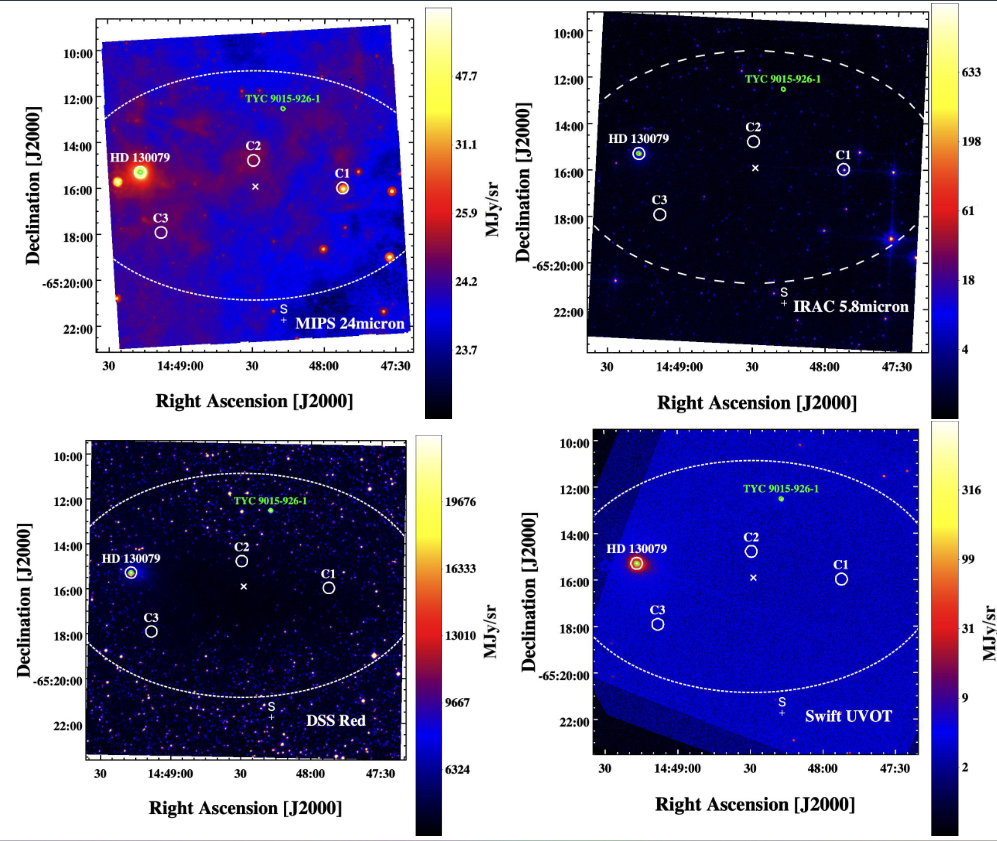Astronomy Object of the Month: April 2024
< previous Archive next >
Multi-wavelength diagnostics of the Molecular Cloud, DC 314.8-5.1
An international team of astronomers led by researchers at the Jagiellonian University Astronomical Observatory, study the multi-wavelength characteristics of the interstellar medium, probing the stellar populations within the dark cloud, DC 314.8-5.1. The team utilized data from the Gaia optical, 2MASS near-infrared, and WISE mid-infrared surveys, dedicated imaging with the Spitzer Space Telescope, and X-ray data obtained with the Swift-XRT Telescope (XRT).

Figure 1: DC 314.8--5.1 region as seen at different wavelengths: (top left) Spitzer MIPS 24 micron log-scaled intensity mosaic map; (top right) Spitzer IRAC 5.8 micron log-scaled intensity mosaic map; (bottom left) DSS red linear scaled image (700 nm); (bottom right) Swift UVOT M2 – 2250 Angstrom band log-scaled map. In each panel, the white dashed ellipse denotes the globule with the central position marked by a white``x''. The green ellipses mark UVOT detected sources with HD 130079 marked on the left and TYC 9015-926-1 marked near the northern boundary of the globule. ``C1'' marks the YSO candidate identified by Whittet (2007). ``C2'' and ``C3'' mark the potential YSO candidates identified in this work. The X-ray source detected with Swift-XRT is indicated by ``S'' with a cross.
The physical state of molecular clouds at a given evolutionary stage is strongly dependent on the development of star formation within such systems. Stars form when the dense cores of molecular clouds collapse, with the infall of material resulting in the gravitational potential energy heating the material and increasing its density to the point of gravitational collapse and consequently a star forming. The main effects of stellar formation are the processing of the dust within the cloud, the disruption of the cloud structure, and heating of the cloud material. These processes continue as the system is altered and disrupted by the evolving young star.
It follows that there in studying clouds prior to the onset of star formation, to study the conditions there. Through the use of multi-wavelength observations, we can probe the conditions in such clouds, as seen in Figure 1. Using observations in optical bands (bottom-left panel) shows the absorption of stellar light by the dust, in infrared we can begin to see the stars hidden behind the cloud (top-right), and even see the emission of the dust itself (top-left), additionally we can see nearby objects using UV observations (bottom-left).
Each wavelength can show different aspects of the system with mid to far infrared observations showing dust emission with cooler dust becoming more prevalent with millimeter observations. Using broadband observations one can inspect the temperature profile of a molecular cloud as seen in Figure 2.

Figure 2: (top) SED of the DC 314.8-5.1 system, based on observations with Planck (filled black circles), IRAS (red crosses), and WISE (open red circles). Dark red solid and dashed curves represent modified blackbody models for the emission of cold (14 K) and warm (160 K) gas within or on the surface of the cloud, respectively; black solid curve denotes the superposition of the two. (bottom) SED of HD 130079 from ground-based telescopes and Gaia survey (small blue stars), WISE (open red circles) and finally with the Swift UVOT (big blue star). Dark blue dot-dashed curve corresponds to the intrinsic emission of the field star HD 130079, modeled as a blackbody with the temperature 10,500 K and the total luminosity of ; dark blue solid curve illustrates this intrinsic emission subjected to the interstellar reddening.
In this research we further discuss the multi-wavelength properties of the dark globule, DC 314.8-5.1, through dedicated observations with the Spitzer Space Telescope and the Swift-XRT and UVOT instruments, supplemented by the archival Planck, IRAS, WISE, 2MASS, and Gaia data. We identified it as an ideal candidate for deeper observations, particularly in high-energy X-ray and gamma-ray.
Original publication: E. Kosmaczewski, Ł. Stawarz et al. “Multiwavelength Study of Dark Globule DC 314.8-5.1: Point Source Identification and Diffuse Emission Characterization”. In: ApJ 959.1 (Dec. 2023), p. 37, DOI 10.3847/1538-4357/ad077a. arXiv: 2209.02372 [astro-ph.GA].
The findings described are part of a study conducted in the Department of High Energy Astrophysics of the Jagiellonian University Astronomical Observatory in Kraków.
|
Łukasz Stawarz Astronomical Observatory Jagiellonian University L.Stawarz [@] uj.edu.pl |


